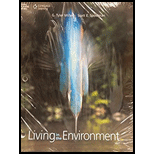
The definition of deforestation and the parts of the world that are experiencing the greatest forest losses. The percentage of the world’s old-growth forests has been eliminated. List some major harmful environmental effects of deforestation. Describe China’s reforestation program. Summarize the story of reforestation in the United States. The ecological roles played by large trees and the reason why they have declined in parts of the world. Explain the way in which increased reliance on tree plantations can reduce overall forest biodiversity and degrade forest topsoil. Summarize the trends in tropical deforestation. Explain how widespread tropical deforestation can convert a tropical forest to tropical grassland (savanna). The percentage of the world’s remaining old-growth tropical forests is likely to be gone or degraded by the end of this century. Describe the loss of rainforest in Indonesia. Describe the key underlying or direct causes and the indirect causes of tropical deforestation. Describe the typical cycle of use and destruction for an area of tropical forest.
Want to see the full answer?
Check out a sample textbook solution
Chapter 10 Solutions
Living In The Environment, Loose-leaf Version
- Outline of topic: Increased urbanization together with climate changes forces cities to find solutions for their simultaneous water shortage and flooding problems. The preservation of water resources needs sustainable urban water management strategies that combine ecological health maintenance with these priorities. This study investigates combined strategies that involve rainwater collection together with wastewater treatment and the deployment of green infrastructure consisting of urban wetlands alongside permeable pavements. The research aims to discover multi-purpose solutions that decrease flood dangers together with water shortages while maintaining ecological health for long-term urban water management success. The research investigates ways in which novel solutions assist cities to create watertight urban areas capable of handling environmental pressures from global warming and population expansion. Research questions: What are the economic, environmental, and social benefits…arrow_forwardTitle: Implementing low impact development: Sustainable water management solutions for urban areas Research questions: What are the economic, environmental, and social benefits of integrating wastewater recycling systems into urban water management practices? What methods can cities employ to resolve water supply needs with natural resource defense while achieving long-term water resource sustainability? Please answer all questions in the pictures in detailarrow_forwardMap 2. Parts 1 through 7. I Dont understand how to answer these questions on the map. Please help me step by step.arrow_forward
- I desperately need help understanding and doing assignment step by step please. Parts 1 through 7 for the one question.arrow_forwardMap 2 parts 1 through 7. I need help with the steps and to understand how to complete the assignment. 1) On the map, draw a single red pencil line that represents the kern river recharge axis. 2) on the map draw 3 to 5 additional red lines in closing what appear to be other smaller recharge areas, possibly the locations of isolated individual recharge points. 3) on the map, draw for useful spaced blue pencil lines that represent groundwater flow from the kern river recharge access into the basin north of the river. 5) on the map, draw any necessary, additional blue pencil lines to fully illustrate groundwater flow from the current river recharge axis. 6) what is the groundwater gradient immediately north of the main recharge area? 7) what is the groundwater gradient immediately south of the main recharge area?arrow_forwardPlease answer all questions and all part questions in detail and show all workarrow_forward
- Shale and siltstone volcanic ash. erosjon surfaçe limestone sandstone erosion surface pegmatite granite slate dike BUY Aparrow_forwardRetreating glacier Bedrock Till Stratified drift ▲ Figure 9.7 This diagram showing common depositional landforms depicts a hypothetical area affected by ice sheets in the recent geologic past. (Drumlin photo courtesy of Ward's Natural Science Establishment; esker photo by Richard P. Jacobs/ JLM Visuals; kame photo by John Dankwardt; kettle lake photo by Carlyn Iverson/Science Source)arrow_forwardFigure 9.9 is a stereogram showing a portion of the area covered by the Whitewater, Wisconsin, topographic map (Figure 9.10, page 160). Use the stereogram and the map to complete the following. 7. The streamlined, asymmetrical hills composed of till, labeled B, are what type of feature? 8. Examine the shape of the features labeled B on the map in Figure 9.10. How can these features be used to determine the direction of ice flow in a glaciated area? 9. Using the features labeled B in Figure 9.10 as a guide, draw an arrow on the map to indicate the direction of ice movement that occurred in this region. 10. What is the likely location of the outwash plain on the map? Identify and label the area "outwash plain." (Hint: Refer to Figure 9.7.) 11. Label the area covered by ground moraine. 12. What term is applied to the numerous almost circular depressions designated with the letter C?arrow_forward
 Applications and Investigations in Earth Science ...Earth ScienceISBN:9780134746241Author:Edward J. Tarbuck, Frederick K. Lutgens, Dennis G. TasaPublisher:PEARSON
Applications and Investigations in Earth Science ...Earth ScienceISBN:9780134746241Author:Edward J. Tarbuck, Frederick K. Lutgens, Dennis G. TasaPublisher:PEARSON Exercises for Weather & Climate (9th Edition)Earth ScienceISBN:9780134041360Author:Greg CarbonePublisher:PEARSON
Exercises for Weather & Climate (9th Edition)Earth ScienceISBN:9780134041360Author:Greg CarbonePublisher:PEARSON Environmental ScienceEarth ScienceISBN:9781260153125Author:William P Cunningham Prof., Mary Ann Cunningham ProfessorPublisher:McGraw-Hill Education
Environmental ScienceEarth ScienceISBN:9781260153125Author:William P Cunningham Prof., Mary Ann Cunningham ProfessorPublisher:McGraw-Hill Education Earth Science (15th Edition)Earth ScienceISBN:9780134543536Author:Edward J. Tarbuck, Frederick K. Lutgens, Dennis G. TasaPublisher:PEARSON
Earth Science (15th Edition)Earth ScienceISBN:9780134543536Author:Edward J. Tarbuck, Frederick K. Lutgens, Dennis G. TasaPublisher:PEARSON Environmental Science (MindTap Course List)Earth ScienceISBN:9781337569613Author:G. Tyler Miller, Scott SpoolmanPublisher:Cengage Learning
Environmental Science (MindTap Course List)Earth ScienceISBN:9781337569613Author:G. Tyler Miller, Scott SpoolmanPublisher:Cengage Learning Physical GeologyEarth ScienceISBN:9781259916823Author:Plummer, Charles C., CARLSON, Diane H., Hammersley, LisaPublisher:Mcgraw-hill Education,
Physical GeologyEarth ScienceISBN:9781259916823Author:Plummer, Charles C., CARLSON, Diane H., Hammersley, LisaPublisher:Mcgraw-hill Education,





